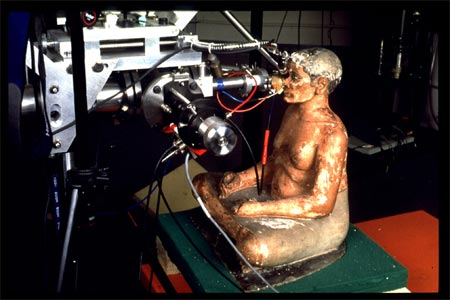Nuclear techniques to investigate remote pasts

An egyptian scribe examined in the Louvre laboratory
Statue representing a crouching scribe from the Egyptian Antiquities Department of the Louvre Museum being analyzed to identify the constituent materials of the eyes. This Scribe from an ancient dynasty would have been very surprised to learn that he would one day come face to face with the small AGLAE accelerator.
© Dominique BAGAULT/LRMF
The radioactive properties of atoms have become valuable tools used by historians and archaeologists in laboratories and museums. Unassuming yet efficient, nuclear techniques are now commonplace in the preservation, identification and dating of historical relics, as well as in uncovering more about their history and how they were manufactured.
Dating (datation) techniques, such as those involving carbon 14 or thermoluminescence, help determine the age of ceramics and a variety of other objects found in archaeological excavations.
Detailed analysis and identification work is performed on these artefacts thanks to highly sensitive equipment originally developed in the field of nuclear physics. In fact, the Laboratoire de Recherche des Musées de France (LMRF), frequently consultedby the Louvre Museum, currently owns AGLAE – a small particle accelerator. The advantage of such an accelerator over the more usual radioactive sources is its ability to direct particles with extreme precision on even the smallest areas of interest.
These accelerated particles (protons, deutérium or hélium nuclei) are capable of producing the same effects (ionisation and possible nuclear reactions) than alpha pzrticles coming from a radioactive source. By examining the effects induced in a sample by a low dose (enough low so as not to damage the sample) one can make astonishing discoveries about its chemical structure. The composition of diamond, a layer of paint or a vase fragment can reveal crucial information about the stone origin, the type of paint used or the potter’s technique.
A major technical development carried out on AGLAE was the exctraction to the air of the beam, thanks to an ultra-thin window. It was no longer necessary to place the objects to be analyzed under vacuum. The air-extracted beam allows direct analysis, without any contact (and therefore non-invasive) of works of art or archeology of any size or shape without sampling or preparation.
The LRMF was the first museum-affiliated laboratory in the world to own such an advanced piece of equipment. In order to fully benefit from these helpful nuclear techniques, the works of art do not have to travel far: an underground tunnel links the Louvre storage facilities directly to the laboratory.
Articles on the subject « Atoms for museums »
The AGLAE accelerator
A modern tool for the analysis of works of art Why use an accelerator to analyze the composition [...]
The PIXE Method
An ultra-sensitive analysis of surface composition The analysis technique mostly used the AGLAE t[...]
The RBS Method
RBS or « Rutherford Backscattering Spectrometry » The « Rutherford Backscattering Spectrometry” o[...]